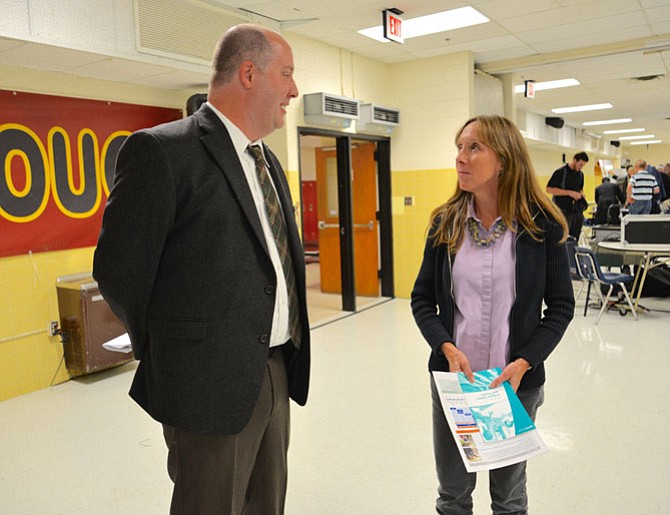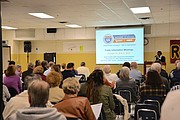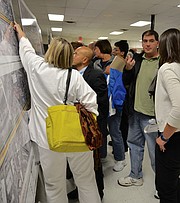Todd Horsley, director of Northern Virginia Transit Programs with the Virginia Department of Rail and Public Transportation, talks with Oakton resident Robin Terry at the meeting to unveil the latest plans for the transformation of the I-66 corridor outside the Beltway. Terry wonders if there will be enough usage of the proposed bike and pedestrian path alongside the highway to warrant the cost. “I didn’t see any studies on that in all of the materials,” she stated. Photo by Andrea Worker.
Susan Shaw, Virginia Department of Transportation (VDOT) Megaprojects director, described the presentation of plans for the transformation of I-66 outside the Beltway as the “pencils down” version of the project. “But public input is still ongoing,” she insisted, and cautioned that alterations for a variety of reasons including the financing of the project and the potential addition of expanded metro services could still affect the final out-of-the-ground results. Shaw was speaking to a packed house on Oct. 19 at Oakton High School during the first of three public hearings to unveil the latest conceptual plans designed to address existing and future transportation problems along the I-66 Corridor from U.S. Route 15 in Haymarket to I-495/Capital Beltway in Fairfax County - not-too-arguably one of the most congested routes in an area that never fails to make the list of worst commutes in America.
In a departure from previous public gatherings on the subject, these meetings (in Oakton, Fairfax and Bristow) were not formatted to allow public commentary, although comment sheets were included in the handouts, and an army of VDOT and other transportation organizations representatives were on hand in front of map boards detailing each section of the 25-mile project, prepared to listen to the public and answer questions as they were able. Instead, the purpose of these meetings, according to VDOT deputy district administrator Renee Hamilton, is to summarize the history of the project and to present what VDOT is calling the “Preferred Alternative Plan” and the proposed phasing of the massive works project from its anticipated start in 2017, until expected completion in 2025.
PHASE I calls for providing two tolled express lanes in each direction starting in Gainesville, safety and operational improvements at key interchanges, and new transit services and park-and-ride facilities. According to Hamilton and Shaw, future elements that could be implemented depending on demand and funding include major reconstruction on accesses at Monument Drive and Stringfellow Road in Fairfax County, express lane access at the Route 234 Bypass, and the widening of I-66 west of Route 28 to make room for further transit expansion in the median. The Phase I works maintains median space for potential metro use east of Route 28. Current estimates put the cost for Phase I at about $2.1 billion, with an estimated $2 to $3 billion for the entire Preferred Alternative Plan.
Hamilton noted that with previous public commentary of some 1,400 submitted comments and approximately 160 small group meetings with various stakeholders, the final proposal was re-worked to lessen impacts on existing homes, parks and businesses. Early plans called for the potential relocation of 35 residential parcels, with impacts to several parks. The Preferred Alternative Plan has reduced that impact to 11 relocations and only one park. Re-draws were made to address citizens concerns about the effect on the recreation areas of Stenwood Elementary School in Dunn Loring.
Comments and suggestions from cyclists and pedestrians were also taken into account. Shaw announced the inclusion of a bike path to run parallel to I-66, usually in front of the 1,200 planned panels to be built for noise abatement, with access to Transit Services and Metro stations. Even though she is a proponent of cycling and pedestrian interests, Robin Terry of Oakton was not convinced about that path, especially if it is to run on the highway side of the barriers. “I’m not sure there will be enough usage of such a path to warrant that expense,” she said. “Really, how much usage will it get? I haven’t seen any studies on that.”
Gayle Curringer of Vienna also has some worries about the effects of the Preferred Alternative after watching the video that the VDOT team played to offer better visualization of the project.
“I know we need to do something, but everything I see here seems to show more and larger access points through some heavily populated places to allow more cars to get on and off I-66. Is that really the answer?
--Gayle Curringer of Vienna
“I know we need to do something,” she agreed, “but everything I see here seems to show more and larger access points through some heavily populated places to allow more cars to get on and off I-66. Is that really the answer? Metro is only mentioned as a pretty big ‘if’ and ‘when,’ with some new bus service thrown in. I just don’t know.”
INFORMATION about the entire project, including the PowerPoint from the Preferred Alternative Plan presentation and a link to the video outlining the project are available at the website www.transform66.org. Project Director Shaw told the assembly that VDOT would be back with more information when procurement decisions have been made and a design team selected.


